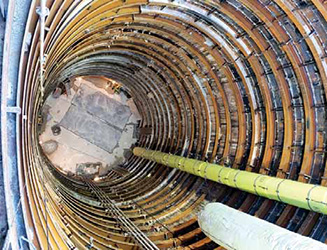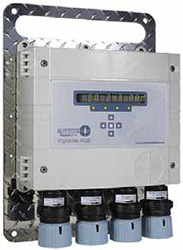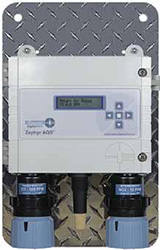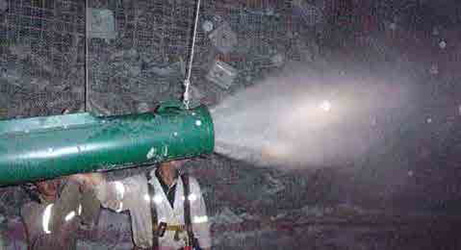
Stantec conducts a detailed engineering study on the ventilation waste heat recovery system
of a large, remote, underground mine. The study leads to an upgrade project that paid for
itself within a year. (Photo: Stantec)
Vent Tech Shortage Hits
Amid Automation Push
Suppliers fill the gaps, design optimization plans, and install high-tech solutions
to help miners get more time at the face and reduce their carbon footprints
By Jesse Morton, Technical Writer

“VOD systems allow for the ventilation system to be more efficiently considered as a sum of their parts as opposed to individual areas, zones or levels,” he said. “The benefit of looking at the system as a whole, which, if sized for a given equipment fleet, greatly helps to prevent the potential of overloading a ventilation stream and presenting a hazardous condition to miners in the form of overexposure to mine gases, diesel particulate matter, and heat,” Spencer said. Further, “inclusive of capital costs, VOD systems yield a net energy savings on the order of 1% of total mining and milling costs.”
The downstream benefits of VOD include streamlined work processes to include the work done by vent techs, he said. “The implementation of VOD systems means that a static condition of air flow across a particular level will no longer exist, and, as such, ventilation technicians are required to be connected to the control network to know and verify the quantity of air flow in a certain area at any given time.” Increasingly vent techs are in short supply. The trend is pronounced and is quietly shaping the industry, according to a Stantec ventilation engineer. The firm has benefitted from business arising from those two trends, as well as a third trend in mines seeking to optimize their existing ventilation systems. “Our ventilation experts are busy,” said Kim Trapani, ventilation engineer, Stantec.
Offering Efficiency,
Flexibility and Control
Stantec is well positioned to answer the
surge in demand.
For example, several customers have
reported difficulties finding and retaining
qualified technicians and engineers. “This
is especially the case for remote mine sites
and generally mirrors the labor shortages
we’re seeing across the industry,” Trapani
said. “Stantec has been supporting these
companies by maintaining their vent models,
providing annual ventilation planning
support, and providing support throughout
the year as the need arises.”
Recently, clients have been increasingly
interested in optimizing their ventilation
systems to boost productivity or to
garner respect from woke investors.
“In general, a lot of clients are interested
in either optimizing their ventilation
system so that they can use the ventilation
infrastructure they have on site
and expand their mines or production
without major ventilation upgrades, or
to reduce their power use for ventilation
to reduce their energy consumption and
reduce their carbon footprints,” Trapani
said. “These types of projects will go a
long way toward helping mining companies
to achieve their greenhouse-gasreduction
commitments.”

Miners are also increasingly adopting battery-electric equipment to cut ventilation needs. “Compared to diesel engines, BEVs require much less ventilation,” Trapani said. “Diesel engines through combustion produce significant air contaminants as well as heat, while BEVs are driven by an electric motor so they do not produce any air contaminants,” she said. “Further, the heat produced by an electric motor is much less than a diesel engine.”
Stantec recently completed a ventilation optimization project for a mine with a face a few kilometers under a lake. “Stantec worked with the client to understand the ventilation system and constraints,” Trapani said. “The winning strategy was to reroute the fresh air directly to the deep end of the mine, so that the air will be colder and to limit the loss of ventilation through leakage.” Stantec then solved how to reduce resistance within the mine to decrease fan pressure and increase ventilation volumes. “Through these measures, the mine could maintain the planned production profile for their deep mining zone and increase the ventilation underground by 94 m3/s with a minimal capital cost,” Trapani said.
The engineering firm is uniquely equipped to answer the surge in demand arising from these trends. “We have expertise with a wide range of both conventional and innovative ventilation and heating and cooling systems,” Trapani said. “Some of those include natural cooling systems for underground mines, other powered-cooling systems, as well as consideration of technologies such as a BEVs. We draw on successes and lessons learned from past projects and other industries to overcome ventilation challenges, and work with the mine operators and project teams to develop innovative ventilation solutions that provide the most benefit.”
The three trends will shape the future of both mining and the ventilation solutions industry. “Low-carbon-emissions targets are fueling investment in low-carbon technology, energy efficient systems and equipment, and sourcing of electricity generation from renewable power,” Trapani said. “Mining companies are looking into the future,” she said. Higher commodity prices are spurring investment in mining, and some of those revenues will go to infrastructure improvement. “We will continue to see companies make capital infrastructure investments that improve ventilation systems, reduce the power requirements for fans, and thereby reduce emissions while not compromising on the air quality and safety of workers underground,” Trapani said. “The ventilation suppliers are working hand-in-hand with mining companies and consultants such as Stantec, developing technologies that will make ventilation systems more efficient and flexible, and will allow operators to have better control of their system.”
Taking Over the West
One supplier that has seized upon those
trends is Turnstone Industrial Solutions.
So much so that the company commissioned
a facility in Elko, Nevada, in Q1
2021. The development capped a year of
solid growth where the supplier aggressively
took more marketspace, said Bryon
Cerklefskie, sales manager.
“We are creating Turnstone West,” he
said.
“A lot has to do with all the seeds
we’ve planted: Doing the hard work, doing
what we say we are going to do, delivering
on time, and proving ourselves,” Cerklefskie
said. “That laid the foundation for us
creating this Western hub of both warehousing
and manufacturing.”

Currently, the facility is predominantly being used for warehousing, but will eventually be used for a fan testing and rebuilding facility, as well as a hub for HardLine and FlexLine ducting. The work area will also be a central landing ground for team engineers and specialists. Having product on hand, including ventbag and fans, is advantageous for a supplier seeing increased demand. “It allows us to respond rapidly and sometimes with a same-day response,” Cerklefskie said. “When we get a purchase order, we can get our truck on the road and to the site to get people what they need fast.”
Currently, the facility has workspace for 10 to 15 personnel, but that number will rise to 20 to 25 within a year. “As we continue to get more business out there, we have plans to make it a really strong hub for us and nobody else is doing that locally, especially for that region, in either fans or ducting, and we’re doing both,” he said. “We take pride in offering a full fan-to-face turnkey ventilation solution.” Trends in mining and ventilation have been good to Turnstone, and it has consistently gained brand recognition since it launched as a joint venture of ABC Technology and the Calandra Group (Jennmar). “It took some time for us to get around and reintroduce some of the products and to dial in to certain customer needs in a fashion they haven’t seen before,” Cerklefskie said. “We can bring in our engineers, do on-site auditing, do modeling, and show the customer the whole array of what they are paying for in terms of CFM per $1 at the face.”
Turnstone’s strategy is to hit the customer with the hard cold facts on solution performance and then let the dominoes fall. “We show them the performance of these different products they’ve tried in the past from different suppliers that left a bad taste in their mouth,” Cerklefskie said. Turnstone then demonstrates how ventilation constraints may have been defining production limits. “That is where we jump in and give them a whole slew of options,” he said. “Then we can offer a small-scale trial of our equipment and measure out what success is or could be.”
The options range from running a rugged vent bag to deploying an industry- leading silencer with a high-efficiency fan or hanging the flagship HardLine semi-rigid ducting. “People are running harder, longer and deeper today. They need a solution,” he said. And the solution must deliver. “The biggest part that helps them succeed is that we do what we say we are going to do,” Cerklefskie said. “If we model something out, and say that if we put this fan in and this type of tubing, we match it up to our modeling.” Which, he said, is not as common a business practice as it should be. “I had a customer in Texas that was floored that we actually did that,” Cerklefskie said. “They hadn’t experienced that before.”

Turnstone scored similar wins at a mine in Nevada, and a copper mine in Utah. The latter was prepped to hang two steel lines when Turnstone was consulted. “Coming in with our HardLine product, we were able to take it down from twin lines to single lines,” Cerklefskie said. “We cut the total anticipated cost from $4 million to $2 million just by letting our engineers look at it.” That is the secret sauce, he said. “We have the best ventilation engineering crew in the industry as far as offering accurate and timely design and modeling, and we couple that with getting the right feedback from the folks underground who use it day in and day out,” Cerklefskie said. “That in turn lets us develop these products that are way ahead of what the industry standard is.”
It is a strategy that has worked, and Turnstone is on pace to double its business in a year. In turn it doubled its manufacturing capacity in Kentucky, and is looking to hire people with mining experience at multiple locations. “With our continued success and consistently delivering what we say we will, and really stepping up to the plate and making sure we supplement the mines any way we can, business is increasing,” he said. “We are quietly taking over the West and redefining the ventilation industry.”
Gaining Recognition
for Excellence
The dueling trends of optimizing ventilation
for improved sustainability and for
production are answered by Maestro Digital Mine’s AQS integrated to ventilation
control software, the company said.
“Proven energy savings are in the
relative range of 25% to 50%,” CEO
Michael Gribbons said. “Greenhouse
gas emissions can be reduced by using
less energy. But what goes hand in hand
with that is giving miners more time at
the face.”
For example, at Rio Tinto’s Diavik
diamond mine, in subarctic Lac de Gras,
Canada, a VOD solution using Maestro
AQSs saved an estimated 12,000
metric tons of CO2 equivalent per year,
drawing praise from upper management
at Rio Tinto.

Both stations were engineered for ease of installation, ease of programming and use, and to rapidly streamline processes. “It is about disruption by elimination,” Gribbons said. “That is really the strategy behind our approach.” The stations can eliminate engineering work, drawings, cabinet designs, approvals and wiring. Other savings come from the reduced space, reduced complexity and the increased real-time data. For example, Vale’s Totten coppernickel mine, in Ontario, deployed Vigilante AQS on an Ethernet network, and the NRG1-ECO to manage an ABB fan control. The VOD solution was ramped up in phases over a period of three years, with the initial expectation of a 50% reduction in energy demand. Ultimately, however, the total achieved savings hit a whopping 61.6%.
Afterward, in a white paper, Vale engineers lauded Vigilante AQS for its ability to streamline. “The most advantageous feature of this device is its ability to be powered over Ethernet. With the fully integrated instrument cluster, the engineering cost for individual schematics and wiring diagrams were eliminated; and with the ability to be powered via Ethernet, there was no longer the need for installation of multiple cables,” said Ozzy Flores, automation engineer, and Enrique Acuńa, efficiency engineer, Vale. “Essentially, this reduced the installation time to that required to erect a small panel and attach a single Category 5 cable. The initial estimate indicated that a savings of 40% of the initially installed system could be achieved.”
Totten “is a great example of NRG1 integrating directly to our digital devices,” Gribbons said. “Totten has publicly announced there are capex savings of more than 45% for just the first round of Vigilantes.” In most cases, capex savings top 60%, he said. “And that is mostly raw material costs,” Gribbons said. Factor in the savings on engineering and labor and it is “probably in excess of 80%.”
Further, the stations feature open architecture, which allow them to integrate easily with control software and other technology. “Our hardware is agnostic and can be integrated into anyone’s software,” he said. Open architecture allows for easier installs and maintenance, and gives the miner sovereignty over the data. Gone is the perpetual scrap over who technically owns the data, which customers love. “Closing everything down and locking everyone out is a protective measure,” Gribbons said. “Mining companies hate it. We’ve taken a different approach: Fully open.” That approach “lights a candle under our butt every day,” Gribbons said. “We have to be a lot better than everybody else. If we’re not, we are on open architecture and could be blown away.”

In late September, Maestro announced it was recognized at the 24th annual Bell Business Excellence Awards gala in Sudbury as Company of the Year for “excellence, continuous growth and success in the underground mine sector.” The award is presented to a company that has demonstrated significant business achievement, sustainable financial performance, outstanding growth and success, and has had a significant impact on the community’s economy.
Offering Reliability,
Solving Problems
Mines that are ahead of the trends, such
as a polymetallic mine in Spain, are reaping
the benefits, according to Conspec. The
mine uses Senturion software and the Optio
IO monitor for ventilation management and
VOD for serious cost savings, said Tanveer
Jahir, business development manager.
“Senturion is a neat piece of software
that creates the opportunity to do a lot
of different things,” he said. “It is a very
powerful tool.”
Popular in both coal and metal mining, Senturion S950 software assimilates, organizes and displays data from sensors and monitors throughout a mine to inform mine managers. It can handle data coming in from up to 255 addresses per trunk line. “You can set it up to control fans, to control doors, to control alarming,” Jahir said. “You can set it up to have a lot of different automation features to where you can take averages over a few different monitors and then use that as your alarm values, turn on and turn off section alarms, and other things like that.”
The software is Windows-based and supports custom graphics. Benefits offered include reduced downtime and increased production, improved safety and lowered costs through improved problem solving. It has been used to help cut ventilation power costs and speed post-blast re-entry. “It is simple and easy to use,” Jahir said. The software has been deployed to mines around the world. Optio IO is a programmable six-input monitor with multiple relay outputs, edge computing capability and that supports multiple communication backhauls. It has an intuitive interface that displays sensor readings, Jahir said. “You can put up to six gases in it.” Using four buttons below the display, the user sets alarms and what they trigger. “It is as simple as saying that at 10 ppm CO, I want it to go to Alarm 1,” Jahir said. “Alarm 1 will trigger Relay 1 to turn on.” Then any time the CO count advances beyond 10 ppm, “the relay turns on, the fan turns on, and it cleans up the air,” he said. “As soon as it goes below 10 ppm, it will turn off.”

Recently, the Optio monitor line was updated to support leaky feeder. “Almost every mine has leaky feeder and are using it mostly for voice,” Jahir said. “Even though it is antiquated technology, a lot of miners are reluctant to remove it because it has worked so well.” The monitors can be configured for battery power. At a mine with a leaky feeder or wireless network, the monitor can be hung and connected to the network, and will run for months. “These monitors in general use a low-powered transmission,” Jahir said. “The monitors give a lot of data for the signal strength. All that data can be seen on the screen on the monitor, which makes it easy to troubleshoot and figure out what is going on.”
The newest sensor that the Optio IO Series of Monitors can support detects particulate matter. “There are about five different particulate sizes that we can measure for,” Jahir said. For use at high-traffic transfer stations, the sensor has a small intake that pulls air through a laser optical trap. “It has a purge mechanism where it will rev up the intake air flow to a high speed to clean out the trap,” he said. Conspec offers the Optio monitors hardened to be explosion proof. “One of the applications is post-blast re-entry where the monitor is hung near the blast zone and after the blasts they get real-time data on the gases from the blast,” Jahir said. “With the monitor and the software, they can determine when to send the crew back down to work. No more waiting and sending someone down in a hazmat suit to determine if the levels are safe to resume work.” Speedy re-entry translates to “more time at the face and less downtime,” Jahir said. “It has really improved productivity.” Glencore’s Kidd mine agreed. The solutions allow a “return to productive work 1-2 hours faster than did previous post-blast inspection procedures,” said Dave Counter, ground control engineer.
The current line of Optio monitors is the climax of more than five decades of evolution. Units of predecessor models released 30 years ago can still be found in mines today, Jahir said. “We built a reputation as a company that makes monitors that are customizable, that are unique to different applications, and that are reliable,” he said. “The monitors do exactly what you want. You can install and then you can forget about them, and they will just run,” Jahir said. “That is how we built up our business, on reliable monitors that solve issues and end nuisance alarming.”
Studies: Water Atomizers Down Dust
Multiple studies concluded that Terramin’s range of water atomizers
can knock down most dust at the working face to improve
the work environment and to help miners comply with health
and safety regulations.

A study at Sibanye Stillwater’s Beatrix gold mine in South Africa tested the ability of the single 8-mm-aperture TERRABLAST to reduce the dust loading in the workplace environment. The study said face drill operators and in-stope workers are the most at risk of exposure to silica dust. “Rock drill operators working without appropriate respiratory equipment will be overexposed and therefore potentially suffer ill health as a result in the long term,” wrote JJL du Plessis, professor, University of Pretoria, and Marthinus van der Bank, environmental engineering manager for the Beatrix mine. “It is therefore anticipated that the use of stope atomizer sprays should reduce the potential exposure.” Dust measurements were taken before and after using the TERRABLAST stope atomizer. Results showed an exposure reduction for in-stope workers of an astounding 80%. “The average respirable dust concentration as determined from personal exposure monitoring results decreased signifi- cantly, with the lowest reduction being measured for the stope team workers at 78.1% and the highest reduction of 85.3% being measured at the winch operator,” du Plessis and van der Bank reported. “The combined average reduction in the TWA quartz concentration across all occupations was calculated to be 79.2%.”
Numerous benefits were also listed. The water atomizer also “wet” the entire face from one fixed point. “There is no need to enter into any unsafe area to water down,” the report said. “The water spray pattern waters down the area, which results in post-blast exposures being reduced and also assists in overall re-entry periods being optimized depending on the ventilation layout system being utilized.” The TERRABLAST delivered a measured airflow of up to 2.5 m3/s. “There is an increased face velocity of 3.3 m/s measured 15 m downstream from the water-blast,” du Plessis and van der Bank said. “There is an increased face velocity measured 30 m from the water-blast to be 1.6 m/s.” Both in-stope as well as vamping workers benefitted from the installation of the unit. An internal report on the usability of the blast-concussion- induced MOUSETRAP water atomizer also identified several advantages. The solution that required no intrinsic safety certification is “cost effective, easy to install, operate, maintain, and is durable,” Terramin reported. “It offers reduced water and compressed air consumption due to the very simple, self-contained hydraulic-timing mechanism regulating the operational time suited to the excavation size needing to be scrubbed.”
Furthermore, the chances of user injury, and, most importantly, “reduced dust and noxious fume concentrations post the blasting operation” made the concept very user friendly, the report said. A similar report on the single 8-mm-aperture TERRABLAST unit showed that, in addition to the abovementioned advantages on the larger MOUSETRAP unit, the TERRABLAST stope water atomizer is lightweight and FRAS compliant. Terramin said the core technology for the water atomizers was invented decades ago. After much trial and error and experimentation following university studies, TERRAMIN “ultimately came up with a very effective way of atomizing water into a size fraction, which was partially sub-micron,” CEO Martin Van Schoor said.
Roughly 95% of the water is airborne and partly in aerosol form. “This enables the proper water droplet surface tension capabilities with the resultant and efficient coalescence and agglomeration of water with dust and particulates,” he said. Similar technologies fail to bring the water droplet size down enough to be truly effective. “What you’re doing is effectively shooting cannonballs through the dust,” he said. “You have to bring the water droplets down to near and an inclusive submicron size fraction so that the dust particle can be adsorbed and not be repelled.”